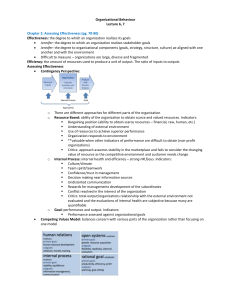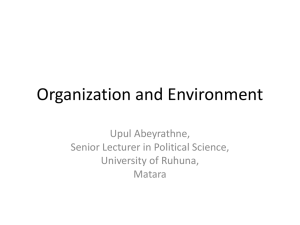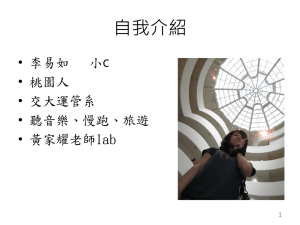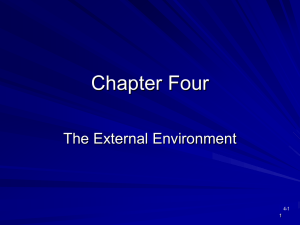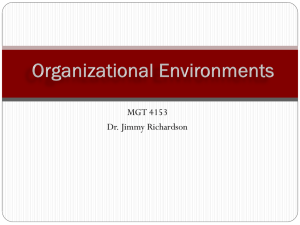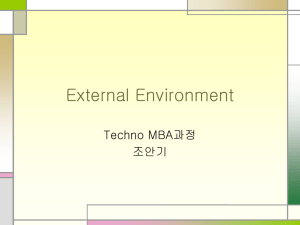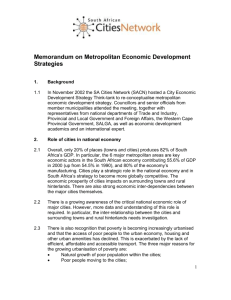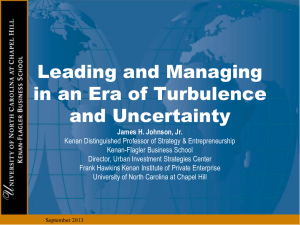The External Environment
advertisement
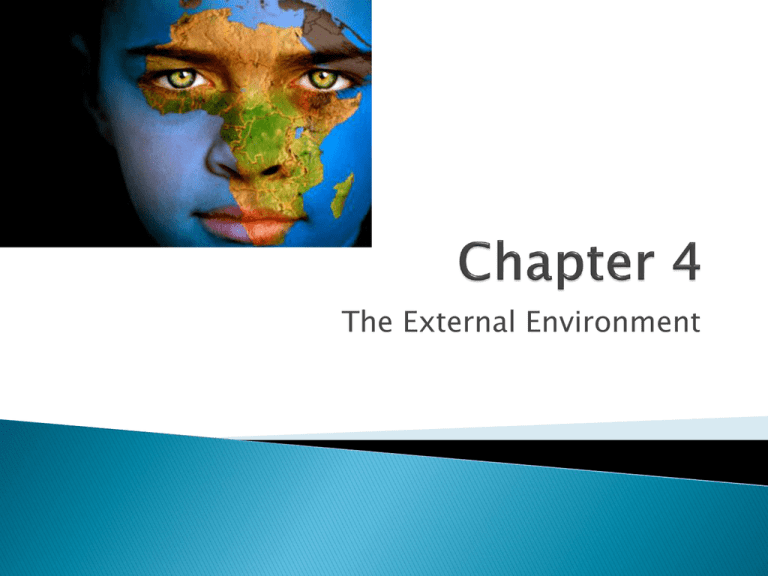
The External Environment 1998: World leading handset manufacturer 2004: Products no longer matched consumer needs , loss of 7% of it’s market share What went wrong? New phones too bulky and expensive Candy bar style Slow to respond to changing customer preferences In the end….. Had to change their target market –waiting to see if their strategy will work.. Organizational Environment- All elements that exist outside the boundary of the organization that have potential to affect all or part of the organization Green Environment- Nature centered organization. Common amongst organizations that are responsible for much of the damage to the natural environment Domain: The companies niche Who they serve and how they serve them External sectors with which the organization will interact with Subdivisions of the external environment 10 sectors for each organization: Industry Technology Raw Materials Economic Conditions Human Resources Government Financial Resources Socio Cultural Markets International Can be divided into: Task Environment General Environment Sectors with which organization interacts directly and that have a direct impact on the organizations ability to achieve its goals: Industry Raw Materials Market Sectors Human Resources International Sectors Sectors that might not have a direct impact on daily operations of a firm but will indirectly influence it Government Socio Cultural Economic Conditions Technology Financial Resources Domestic sectors can be affected by international events! How? 1) The need for information about the environment 2) The need for resources from the environment Scarce material and financial resources- need to ensure their availability ! Uncertainty- Not having sufficient information about environmental factors which results in a difficult time predicting changes * What does this cause? * Concern’s with environmental complexity Heterogeneity or number and dissimilarities of external elements relevant to the organization’s operations. The more external factors that regularly influence the organization + increased number of competitors = Greater Complexity Does the environmental domain remain the same over a period of months/years Are changes predictable? Stable Vs Unstable Simple + Stable= Low Uncertainty Complex + Stable= Low-Moderate Uncertainty Simple+Unstable= High-Moderate Uncertainty Complex + Unstable= High Uncertainty ^ in complexity and uncertainty in external environment increases means a ^ in # of positions and departments ^ internal complexity Each sector in external environment requires an employee/department to deal with it Absorb uncertainty from environment Surround technical core Exchange resources/materials between environment and org. New approach! Detect changes in environment and bring info to org. Send info. into environment that presents org. in favourable light New Approach = Business Intelligence High-tech analysis of data to spot patterns and relationships Competitive intelligence: systematic way to collect/analyze info about rivals and use it to make better decisions Differences in cognitive and emotional orientations. Results in difference in formal structure among these departments. Paul Lawrence, Jay Lorsch Each dept evolved towards different orientation. Structured to deal with specialized parts of external environment. R&D informal structure, long-term orientation, task-oriented employees and marketing was at opposite end of spectrum . Outcome of high differentiation: Coordination among departments becomes more difficult. Integration: Collaboration among departments. Who : Project managers, liaison personnel etc. When environment is highly uncertain: Frequent changes Require more information Processing to achieve coordination Integrators become more necessary When environment is simple and stable: Few managers assigned to integration roles Lawrence/Lorsch concluded: Organizations perform better when differentiation/integration matches level of uncertainty in environment Burns/Stalker: Observed 20 industrial firms in England External environment is related to internal management structure Mechanistic management structure: Stable external environment Rules, procedures, clear hierarchy of authority Communication is vertical Organic Management : Rapidly changing environment Free flowing and adaptive Hierarchy of authority not clear Communication is horizontal Organic process Enhances organizations ability to quickly respond to changes Uncertain environment: Planning/forecasting become more important Planning softens impact of external shifts Organizations depend on the environment Strive to acquire control over resources Costs+ risk = high Team up to share scarce resources Relationships create dilemma: Trade-off: resources autonomy Organizations with abundant resources avoid relationships Organizations balance relationships/autonomy, by controlling other organizations Two strategies to manage resources in external environment : Create linkages with key organizations in environment Shape environment to suit focal organization Aquisition: purchasing of one organization over another-buyer assumes control Merger: Unification of two or more organization’s into a single unit Strategic Alliances: High level of complementarity- skills, geographic positions License Agreements Supplier Arrangements Joint Venture: creation of a new organization formally independent from its parents (parents have little control) Cooptation: leader from important external sector made part of an organization Interlocking directorate: Member of the board of directors of one company sits on the board of directors of another company. Direct Interlock Indirect Interlock Executive Recruitment: transferring/exchanging executives Advertising: Traditional way of establishing relationships Large amounts of time and money Influence taste of consumers Very important in highly competitive industries Public relations: Stories aimed at public opinion Four traditional techniques: 1) Change of domain - Acquisition and divestment 2) Political Activity, Regulation - Influence legislation and regulation 3) Trade Associations - Organizations influence environment jointly 4) Illegitimate Activities - Conditions cause managers to take part in unlawful/unethical activities Companies experiencing low demand, shortages, strikes: More likely to take part in illegal activities Attempt to deal with resource scarcity Complexity in the environment has a big impact on organizations Decisions are made based on the external environment Stable-unstable and simple-complex dimensions Resource dependence An organizations departments are created to deal with uncertainties. Departments buffer uncertainty. When resources are scarce, organizations can establish linkages. Cross functional communication Find the Right Fit between Internal Structure and the External Environment As complexity ^ more positions have ^ complexity! Avoid selective hearing/wishful thinking
